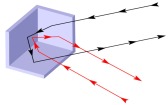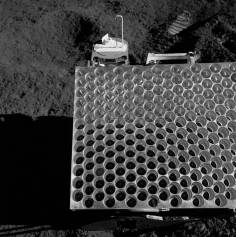
As everyone knows, left and right are swapped in a mirror image. Or are they? It is really front and back that are reversed, but that’s a story for another day.

During a visit to the Science and Industry Museum in Paris some years ago, I stood facing a spinning mirror. Lifting one arm, I saw in the image the arm on the opposite side raising. Sacrebleu, the device was a non-reversing mirror.
In its simplest form, a non-reversing mirror comprises two mirrors at right angles to each other (see Figure). An incoming light beam bounces from one mirror to the other and emerges in the direction opposite to that at which entered.
This works only in two dimensions: when the light beam is in a plane orthogonal to the two mirrors, it remains in this plane. In general, we need three mirrors to ensure the beam can return in the direction whence it came.
Retroreflectors

Light hitting a mirror is reflected at the same angle as the incoming beam, but on the opposite side of the normal line. Only when the beam is perpendicular to the mirror does it act like a retroreflector. A retroreflector is an optical device that returns incoming light back to its source. Retroreflectors come in several forms, two of which are small glass spheres as in the old cats-eyes, and corner reflectors or prisms.

A corner reflector, or corner cube, consists of three flat mirrors at right angles to each other. The geometry is similar to what we see looking up at the corner of a room: the two walls and ceiling comprising three mutually orthogonal planes. Glass prisms made from the corners of a solid glass cube are also used. An incoming ray is reflected three times, once by each surface, causing a reversal of direction (see Figure). The outgoing ray is parallel to that coming inwards.
A large retroreflector can be made by forming an array of many small reflectors in a hexagonal pattern. This is the form often found in tail-lights on cars and trucks.
Corner reflectors do a good job at long distances. Spheres are good when the observer is displaced from the light source, as is the driver of a car from the headlights.
On the Road
Retroreflectors are now crucial for night-driving and are seen on all major roads. They are on the tail-lights of vehicles, safety barriers, traffic signs, and the painted stripes that separate lanes of traffic.
Road-signs and painted stripes are coated with tiny retroreflectors. In the simplest of these, clear glass beads are poured over freshly painted road stripes and signs. Traffic signs are coated with retroreflective paint or have sheets embedded with tiny plastic prisms or corner cubes. When illuminated by headlights, they glow brightly, reflecing the oncoming light back to the source. This is similar to the way drivers see animals’ eyes at night, the eyeshine where the eyes glow brightly in car headlights.

Retroreflectors on the Moon
The image below shows part of the Apollo 15 lunar Laser Ranging RetroReflector (LRRR) array. It was placed on the Moon on 31 July 1971. The Apollo 15 array is one of four such arrays on the Moon. The others were placed by the Apollo 11 and Apollo 14 missions and by the Lunokhod 2 rover. Another use of retroreflectors is on artificial satellites. These enable very precise tracking from ground stations.
The Apollo 15 array is the largest array, with dimensions 105 cm x 65 cm, and is the primary target for laser ranging to the Moon. Using it, the distance from the Earth is routinely measured to an accuracy of about a centimetre. These measurements allow us to determine precisely the orientation and orbit of the Moon. The return signal is very weak, impossible to see with the human eye. Even under good viewing conditions, just one photon is received every few seconds!
For fifty years, observatories around the world have aimed laser beams at the Moon and detected the returning light from the retroreflectors to measure the distance between the Earth and Moon. The coordinates measured using the LRRR arrays are the points on the Moon whose positions are most accurately known, and they are used to provide a global absolute latitude and longitude lunar coordinate system.
The LRRR has allowed us to determine the rate at which the Moon is receding from Earth. This will have major impact on our climate. However, the time-scale for this is very long: the current separation rate is about 4 cm per year.
Retroreflectors: Do It Yourself
A simple retroreflector can be made from 3 mirrors arranged to form a corner of a cube. Instructions are available online: see reference to Make magazine below (don’t forget: never look directly at a laser beam or its reflection).
Sources
Wikipedia article Retroreflector.
The Apollo 15 Lunar Laser Ranging RetroReflector. NASA.
Measuring the Moon’s Distance. NASA.
How to Make and Use Retroreflectors. Make Magazine.
